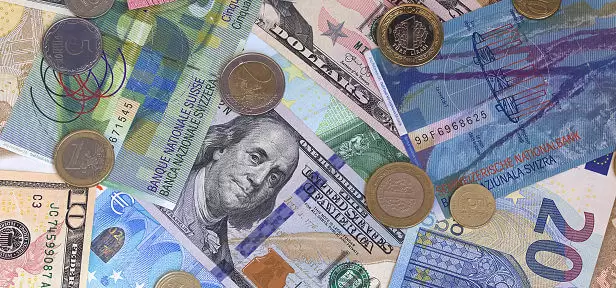Exchange rates by transaction type
If you would like a detailed breakdown of the rates used by many Swiss banks for different kinds of foreign currency transactions, enter your email address in the field below and click on “Request free PDF”.

For the first time, moneyland.ch conducted a thorough analysis of the currency exchange rates used by Swiss banks. The verdict: Swiss banks generally add high markups to currency exchange rates. But exchange costs vary broadly depending on the bank, currency and amount involved, and whether the banknote rate or forex rate is used.
Currency exchange is a billion-franc industry in Switzerland. In addition to capital gains on forex trading, banks also earn money on the everyday foreign currency transactions performed by their customers. Every time Swiss consumers withdraw foreign currency at ATMs in Switzerland or abroad, use their debit cards to settle payments outside of Switzerland or make international money transfers, banks are normally taking a cut. What many consumers do not know is that the foreign transaction fees listed by banks make up only part of the cost. Markups on interbank currency exchange rates add a significant and often overlooked expense for bank customers.
Currency exchange rates compared
Independent Swiss online comparison service moneyland.ch performed a thorough analysis of the banknote rates and forex rates used by more than 40 Swiss banks for 5 foreign currencies (euro, U.S. dollar, British pound, Thai baht and Swedish krona). Rates used by the currency exchange offices of the Swiss railway operator SBB/CFF and the Coop Depositenkasse were also analyzed. As part of this study, moneyland.ch recorded the daily exchange rates applicable on 6 days. These figures were then evaluated and average rates were calculated based on collected data.
The results of the analysis show that on average, currency exchange rates are unfavorable for consumers. This is especially true in the case of banknote rates which are used when bank customers obtain foreign currency in cash at bank tills. The differences between banknote rates, forex rates and markups used for different currencies and amounts by different currency exchange offices are major.
Markups added to exchange rates by the most expensive currency exchange services are, in some cases, more than 3 times higher than those used by the least expensive service providers. When compared to Swiss banks, the banknote rate used by SBB/CFF falls on the higher end of the scale. The banknote rates used by the Depositenkasse Coop, on the other hand, are among the most favorable rates for euro and U.S. dollar purchases, among others.
Banknote and forex rates by currency
The proportional difference between the buy and sell rate – commonly referred to as an exchange rate spread – indicates the cost (excluding additional fees) of exchanging a currency for another and then exchanging that currency back into the original currency using the same exchange service. The markup for a one-way currency exchange is normally half the amount indicated by the spread. The average spread used by the banks included in the analysis are 5.16% for euros, 7.81% for U.S. dollars, 9.34% for British pounds, 12.03% for Swedish kronor and 14.98% for Thai baht. You can request a detailed breakdown of the currency exchange spreads used by each bank at the foot of this article.
Bank customers who exchange Swiss francs for Thai baht at the average banknote rate and then exchange the Thai baht for Swiss francs again lose around 15% of their money in the process. Performing the same exchange at the exchange service with the largest spread would result in a loss of more than 26%.
Forex rates, which are used for many remote transactions, have significantly lower average spreads than banknote rates. The average spreads of the forex rates used by Swiss banks are 2.92% for euros, 3.1% for U.S. dollars, 3.15% for British pounds, 3.52% for Swedish kronor and 5.08% for Thai baht.
Important: The currency exchange rates and spread are not the only factor which must be accounted for when determining which exchange service is the most affordable. Firstly, exchange services may use different rates for different types of transactions. Secondly, various additional fees may apply to certain types of transactions. Thirdly, the amount which you exchange may affect the size of the exchange spread, with smaller spreads used for larger volumes.
Euro rates compared
The arithmetic mean average spread for Swiss franc to euro exchanges at the banknote rate across the exchange services covered by the analysis is 5.16%. The spread on a one-way exchange of Swiss francs for euros is around half of that. On average, customers lose more than 5% of their money when they exchange Swiss francs for euros at the banknote rate and then exchange the euros for Swiss francs at the same exchange service. The most affordable provider has a spread of 2.86%, while the spread used by the least affordable service provider is nearly 3 times higher than that at 7.98%. The arithmetic mean average spread used for forex rates is much lower, at 2.92%. The 3.92% forex rate spread used by least affordable service provider is around twice as high as the 1.98% spread used by the most affordable service provider.
U.S. dollar rates compared
The arithmetic mean average spread for Swiss franc to U.S. dollar exchanges at banknote rates across the banks and exchange services included in the analysis is 7.81%. The spread for a one-way exchange from Swiss francs to dollars would be around half that size. On average, customers lose around 8% of their money when they buy U.S. dollars at the banknote rate and then change them back into Swiss francs using the same exchange service. The most favorable banknote rate offered has a spread of 5.05% while the least favorable rate offered has a 9.54% spread – almost double that of the most affordable rate. U.S. dollar forex rates are more favorable than banknote rates, with a 3.1% arithmetic mean average spread for Swiss franc to U.S. dollar exchanges. The spread used by the service provider with the least favorable forex rate is 3.96%, while the most favorable forex rate available has a spread of 2.38%.
British pound rates compared
The arithmetic mean average spread for banknote rate Swiss franc to British pound exchanges across analyzed exchange services is 9.34%. The spread for a one-way exchange would be around half of that. A customer performing a two-way exchange from Swiss francs to British pounds and then from pounds back into Swiss francs at the average banknote rate spread would lose more than 9% of their money. The most affordable exchange service analyzed has a banknote rate spread of 4.05% while the spread used by the most expensive service provider is around 3 times higher than that at 12.23%. Forex rates are more favorable, with an arithmetic mean average spread of 3.15%. The least favorable rate offered has a spread of 3.92% while the most favorable rate has a spread of 2.38%.
Thai baht rates compared
The arithmetic mean average spread for Swiss franc to Thai baht exchanges at banknote rates is 14.98%. The spread would be around half that size for a one-way exchange of Swiss francs into Thai baht. Customers who exchange Swiss francs for Thai baht and back at the average banknote rate spread lose around 15% of their money. Of all the exchange services analyzed, the service with the most favorable banknote rate has a 7.69% spread, while the least favorable banknote rate has a 26.06% spread – around 3 times higher than that of the most favorable rate. The arithmetic mean average spread of the forex rates used by analyzed exchange services is 5.08%. The exchange service with the least favorable forex rate uses a spread of 9.52%, while the spread of the most favorable rate is 3.03%.
Swedish krona rates compared
The arithmetic mean average spread for Swiss franc to Swedish krona exchanges at banknote rates across analyzed exchange services is 12.03%. The spread for a one-way exchange from Swiss francs to Swedish kronor is around half that size. Customers who change Swiss francs into Swedish krona and back at the average banknote rate spread lose around 12% of their money in the exchange. The exchange service with the most favorable rate uses a 7.69% spread. The spread of the least favorable rate analyzed is more than twice as wide at 16.03%. The arithmetic mean average spread for exchanges made using the forex rate is 3.52%. The most expensive exchange service uses a 4.97% spread, while the cheapest uses a 2.21% spread.
More on this topic:
Banknote rates and forex rates in Switzerland
If you would like a detailed breakdown of the rates used by many Swiss banks for different kinds of foreign currency transactions, enter your email address in the field below and click on “Request free PDF”.
Cheap bank accounts with card
Yuh
No account fees
Banking partner: Swissquote & Postfinance
CHF 20 trading credit with code «YUHMONEYLAND»
Alpian
Multi-currency account with Visa card (CHF, EUR, USD, GBP)
Favorable foreign exchange rates
CHF 100 welcome bonus
UBS key4
50 KeyClub points as a welcome gift
Online private account with debit card
Brokers with low fees
Saxo Bank Switzerland
Licensed Swiss bank (FINMA)
No custody fees when securities lending is activated
Free expert research and trading signals
Cornèrtrader
Swiss online bank
No custody fees for stocks
Free market research and trading signals
Leading credit cards
Swisscard Cashback Cards Amex
No annual fees
Two cards Amex & Visa/Mastercard
With cash back
Migros Cumulus Visa
No annual fees
With Cumulus points
Without foreign currency fees
